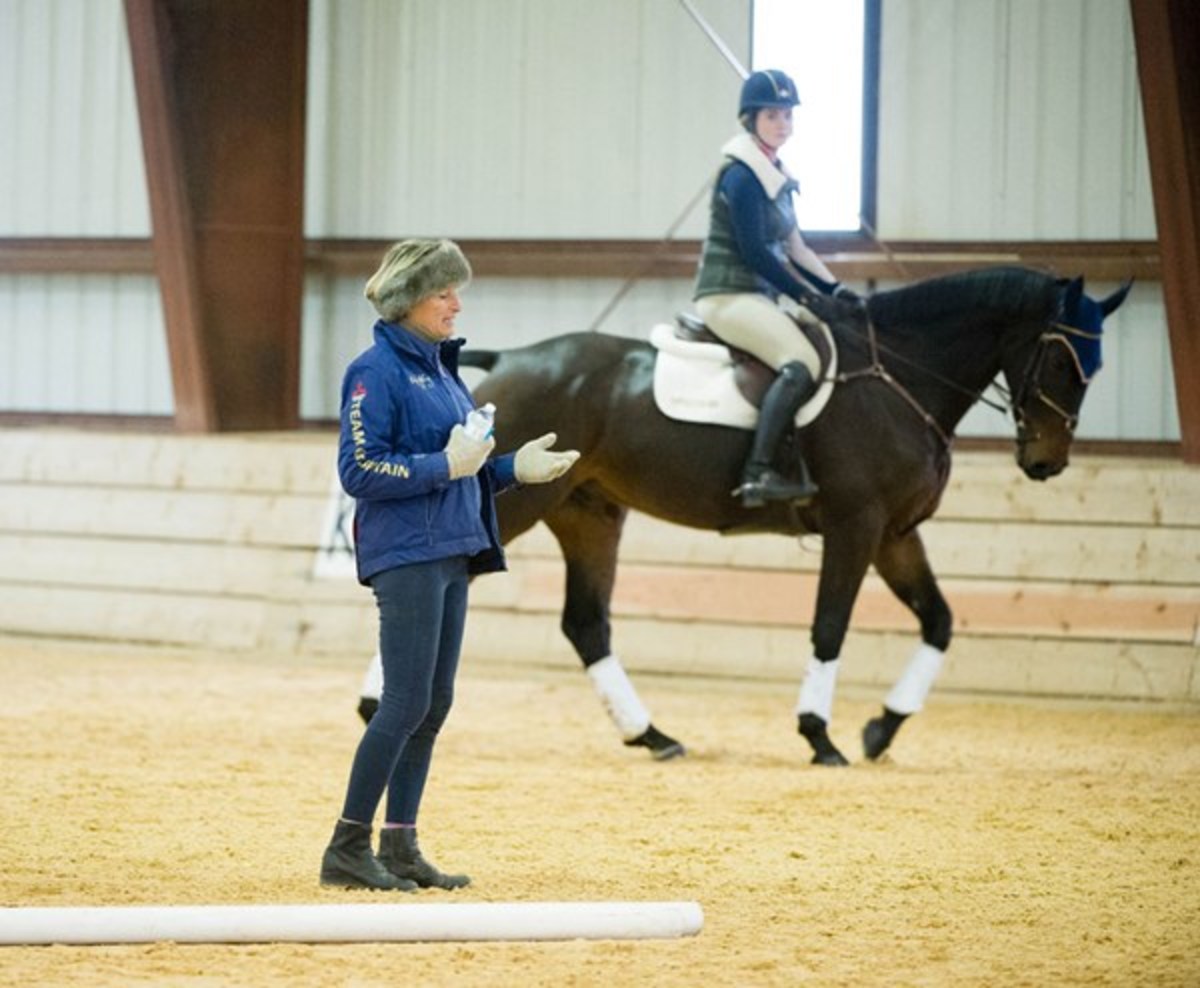
Bundled in a Team Great Britain coat and furry headband to ward off Virginia’s unusually frigid temperatures, six-time Olympic eventer Mary King displayed her dedication to correct riding throughout a two-day clinic at Morven Park in Leesburg last fall. The British eventing star used several deceptively simple exercises—that turned out to challenge many of the 20 riders and their horses—to improve their foundational skills. The clinic, organized by Kelly Gage of Team EnGaged Clinics, included young horses just starting their eventing careers to older horses competing at the three-star level.
Mary’s focus on the first day was to improve the riders’ positions and the horses’ responses to the aids on the flat. This set the groundwork for the second day’s eagerly awaited jumping work over fences that were angled, skinny or just plain tricky.
“Mary reinforces discipline and the importance of the basics,” said clinic rider Jane Jennings afterward. Added another clinic rider, Megan Hinkle, “The most important lesson I learned from Mary was that the more solid your base is, the higher the pyramid you can build.”
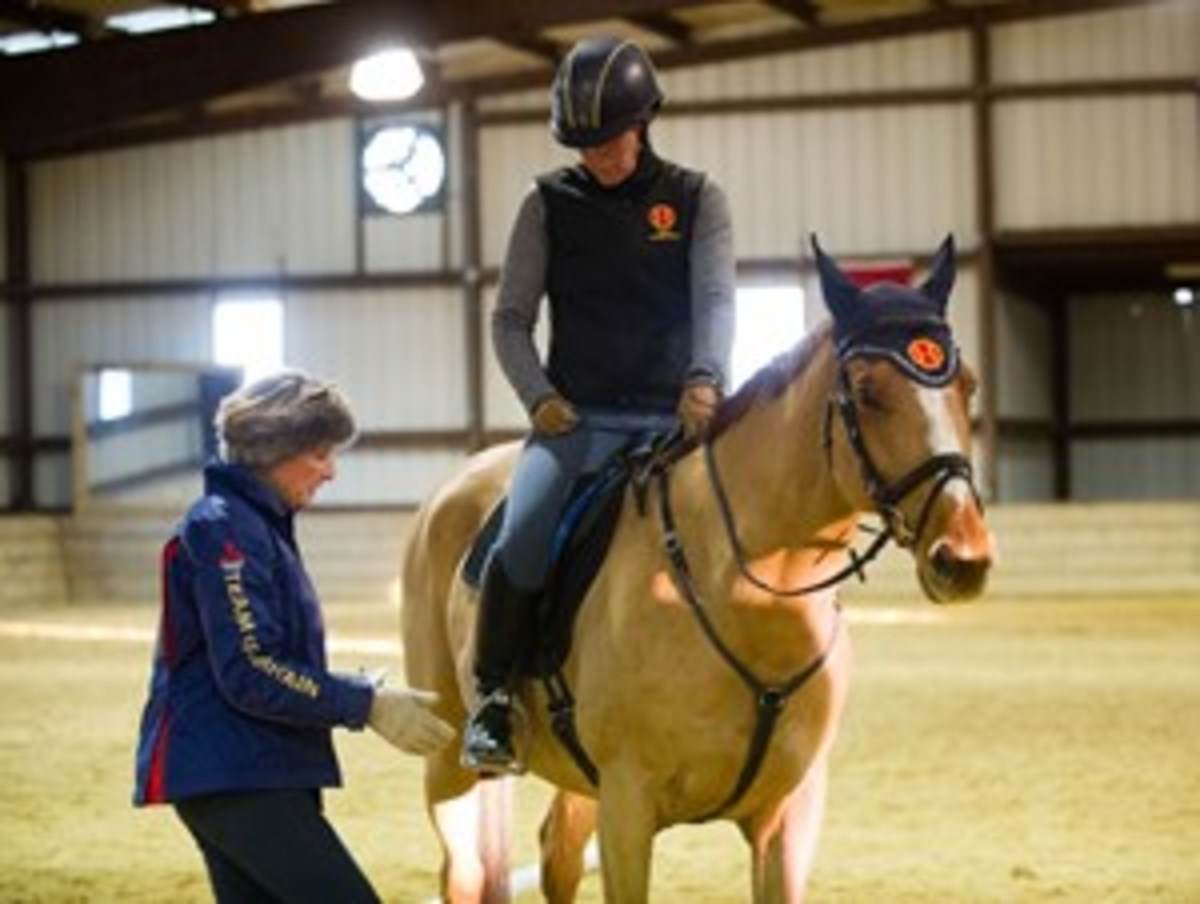
Flatwork
Warm-up
On the first day, every rider was reminded to work with the appropriate length stirrup for flatwork. Most were asked to put their stirrups down a hole or even two. Mary also pointed out that all tack should fit properly. One rider was asked to loosen her breastplate. A couple of saddles appeared to fit less than perfectly, causing her to comment on the relationship between good saddle fit and performance. She also discussed the fit of horses’ protective equipment. She explained, for example, that if bell boots were too long, the horse could step on the back of them and fall, especially on cross country. Ideally, the bell boot should fit over only the heel bulb and not strike the ground as the horse travels. Mary uses pull-on boots that can be cut to the correct length.
Warm-up on the flat was 10 to 15 minutes of free work, including long-and-low walk, trot and canter. Watching the horses go around the large indoor arena, Mary explained that they must reach into a long frame to warm up all their muscles properly. As the horses stretched down and around, the riders needed to keep contact. This work also allows them to get out any “jollies” they might have, she added.
Mary also helped riders smarten up their positions throughout the warm-up. She encouraged them to ride with an upright body by “making the front of your body longer,” a phrase she borrows from Carl Hester, a member of Great Britain’s 2012 Olympic gold-medal dressage team. She reminded riders and auditors that the upright position allows the “bottom to sink into the saddle” and stressed taking time to focus on position in the warm-up.
Transitions
Once the horses were warmed up and the riders’ positions more solid, Mary asked them to practice a series of transitions starting with walk–trot–walk, followed by trot–canter–trot, walk–canter–walk and trot–halt–trot. Exercises for the more-advanced horses included canter–halt–canter and moving between collected, working and medium gaits. The lesson’s intent was to sharpen the horses to the leg and seat aids and to have the riders become more effective with their bodies while becoming less reliant on the rein aid. No pair moved on from the basic walk–trot, trot–canter transitions until the horses were stepping into the down transitions and in front of the riders’ legs and were sharp off the leg for the up transitions. If horses were sluggish and the riders used the spurs too often, Mary had them give a good slap with both legs. This helped the horses remember that the leg meant, “Go forward!” When a horse did not step down into a transition well, Mary reminded the rider to “keep the hind leg active” through the transition. In short order, all the horses improved their way of going and the riders were more effective. “This is all very basic stuff. If you can get it, you have a broad base to start your career,” Mary said. A narrow base will limit your progress, she added. With a broad base you can go further.

Canter poles on a circle
For the next lesson, Mary placed four poles on the approximate, though not perfect, quarters of a 20-meter circle and asked riders to canter just one of the poles to start, staying on the circle by going around the other three poles. The young horses struggled to stay on the circle and canter a pole. Often they would try to jump the pole to make it easier. They finally all got the idea as Mary reminded riders to try to meet the pole in the striding. Once the horses had mastered one pole, she asked the riders to add the second, third and fourth poles in sequence. Remembering that the poles were not spaced evenly was the key to this exercise. As the riders added each pole, the better their eyes had to be and the more adjustable the horses had to be. Some horses rode the exercise in five to six strides while others did it in four to five strides. The more-advanced horses and riders had to count aloud the number of comfortable strides between the poles. As they progressed, Mary upped the difficulty by giving them a new striding pattern to ride. Sometimes they were asked to add a stride, sometimes take one away. For example, a four stride might become a three stride or a five stride while a five might become a four or a six. All the horses became much more reliable in their adjustability as well as their throughness.

In this exercise, Mary was as much a stickler for rider position as she had been during warm-ups. If riders leaned forward, she quickly reminded them to “keep the front of your body long.” If they pulled up their legs or moved them too far back, she would correct the riders. If the seat came too far out of the saddle, she would tell them to “sit on the back of your bottom.”
Every group ended by being able to ride the poles smoothly and on stride. Mary stressed that riders needed to continually challenge themselves in this exercise by changing the stride with the goal of improving the adjustability in the striding. Nothing should be static with this exercise.
“Mary is nice and helpful but demands excellence all the time,” said rider Jenna Calcaterra after the clinic. “I was reminded that dressage is the fundamentals of riding. Her saying, ‘Ride taller in your body’ made a big difference for me.”
Jumping
On the clinic’s second day, the riders warmed up while keeping in mind the previous day’s lessons. Emphasis was on stretching long and low in the walk, trot and canter. Mary again looked for proper rider position, this time with cross country in mind. She explained that the proper seat for cross country needs to be close to but not on the horse’s back. “You should touch the saddle with your bum as you’re traveling around the course,” she said. She added that the upper body should remain upright, not collapse downward.

Next, riders trotted a single crossrail to start thinking about jumping. Then they moved on to the first jumping exercise.
Playing with a triple line
Mary first set a single oxer on an angle out of a corner on the near side of the arena and a triple combination on the far side, placed several feet in from the arena wall so riders could work on both sides. It was a short one-to-one stride and 3-foot-6 for the upper-level horses and a two-to-two stride and 3 feet for the younger horses.
The first task was to ride the first and third fences on a figure eight. Riders approached the first fence on a diagonal, jumped it and looped around the second and third fences on the way back to jump the third from the other direction. It was critical that the canter stay powerful in the loops. If it got too dull, the riders had to gun the horses at the fence. If the canter was too open, the horses jumped from long or short distances. Mary used the metaphor of bouncing a basketball to explain controlling the power of the canter: If you want a ball to bounce higher, you don’t push it down more quickly or slowly, you push with more power.
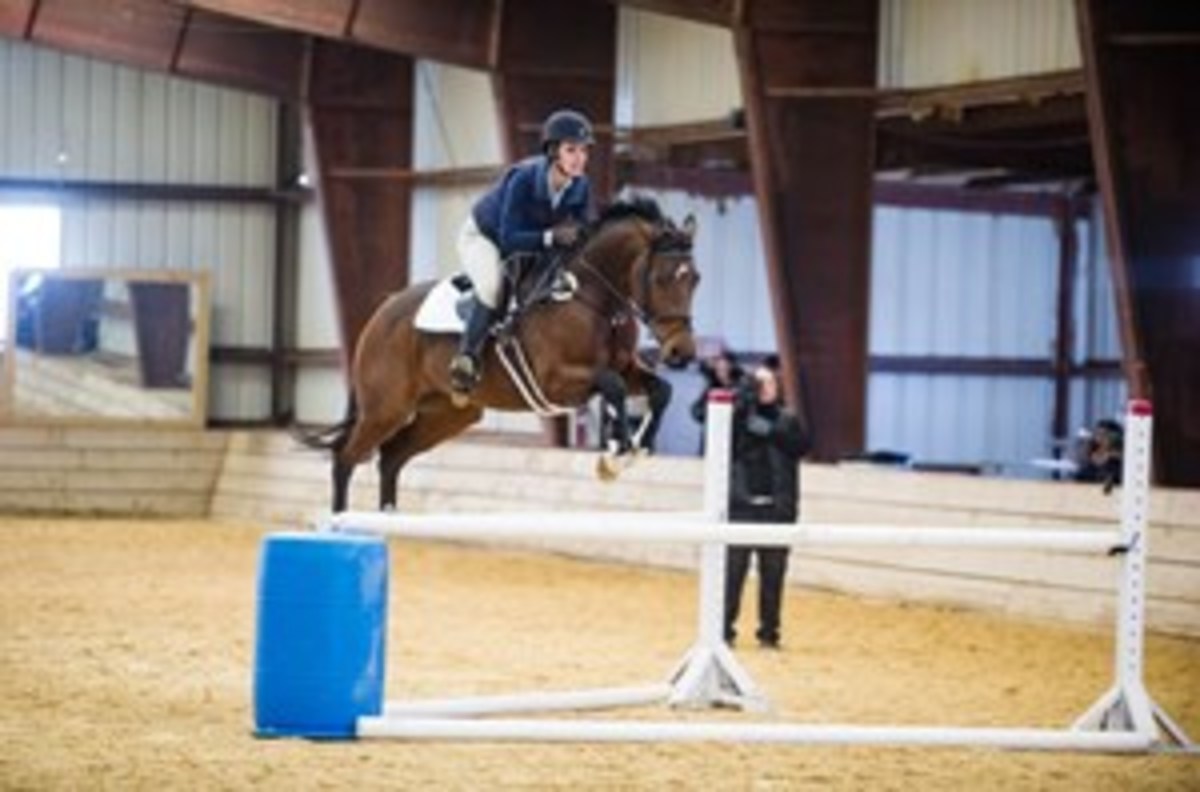
The next exercise was to approach the first fence of the triple on an angle and jump it, bypass the second fence and jump the third fence on the opposite angle. The goal was to create a smooth line, landing and moving forward to the next jump. It needed to be ridden as if the horse were on a “train track,” Mary said. Finally, the second fence of the line was jumped on a figure eight by itself. Again the riders were asked to keep the canter active, punchy and powerful. If they did well, they continued through the entire triple line.
Through all the jumping exercises, the attention to proper position never waned. Almost every rider heard at least once, “Not too forward with the shoulders.” Mary explained: “Horses are easily disturbed by riders who move too much with the upper body.” Some riders struggled with landing into their leg over the fences. To help, Mary had them put their legs slightly more forward as they approached the fence while working on keeping them there on landing. This kept the horses more balanced and able to canter away from the fence better. All of these jumps ridden on angles prepared the duos for the task of jumping narrow and corner fences.
Bounce to a related narrow or corner
After a reset of fences, the riders were presented with a new exercise: a bounce on the centerline with a long bending four strides to either a blue upright barrel set between two standards to the right or a corner made up of poles that came together on another upright barrel to the left.
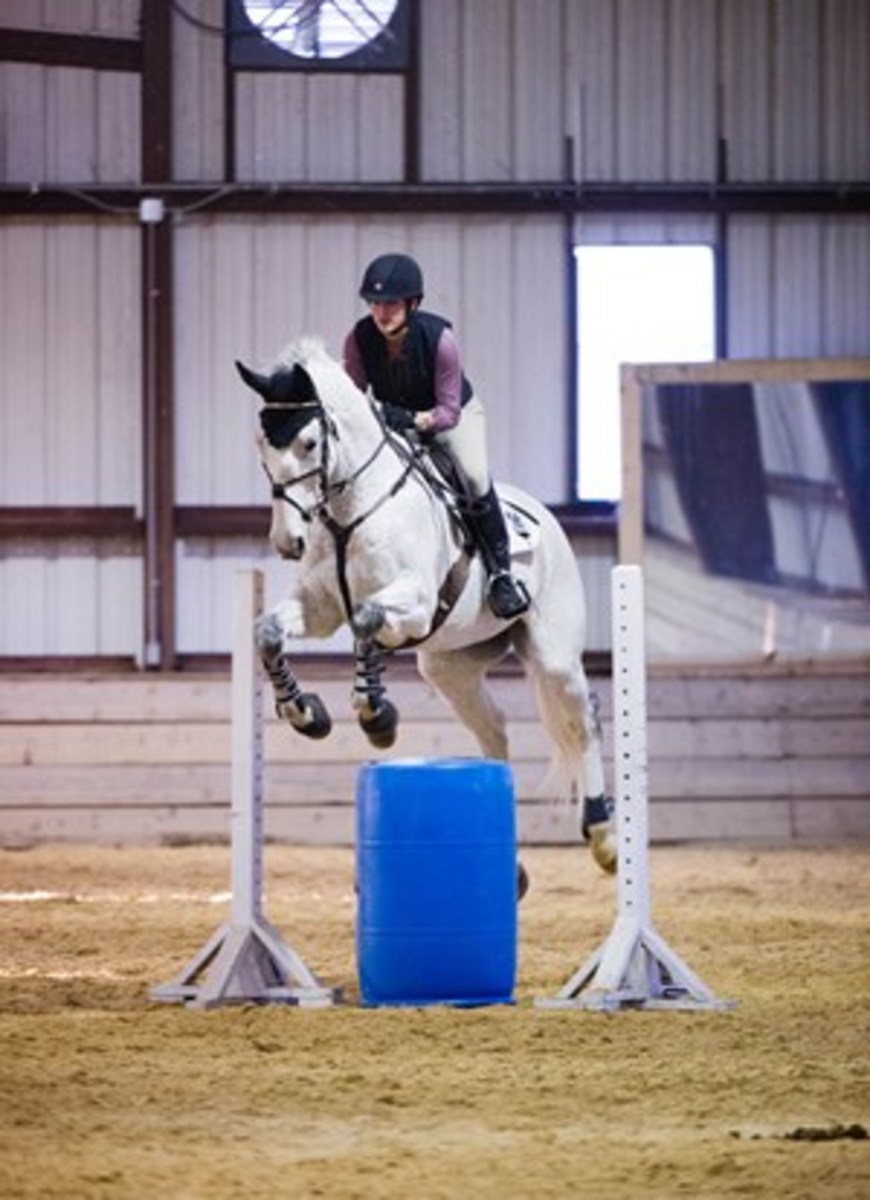
A few horses and riders were surprised at having to shorten their strides for the bounce and then lengthen them for the other fences. Using the same idea as the canter poles of the first day, Mary had the riders find the easy striding, keeping power and adjusting as needed. Once the riders had mastered the bounce to a related fence, Mary had them continue riding around the end of the arena and do the exercise in the opposite direction.
The goal of this exercise was to show that as the cross-country courses become more technical, riders can still keep going forward and not go to the hand too much. Riders learn to go forward with power, not speed, to a tricky or narrow fence.
A few younger horses had not experienced narrow fences before, giving Mary the opportunity to explain her method of introducing them to a young horse: Start with three upright barrels with two wing poles. Once the horse jumps that comfortably, remove one barrel and drop the wing poles to the ground. Finally go to one barrel with upright standards on either side.
After the jumping, Claire Robinson said, “Mary was so helpful. I have a weak eye for distances. The exercises helped me improve.” Added four-star rider Allison Springer, who was on her recent ride, Mr. Sydney Rocks, “This is a new horse for me, and my experience with Mary was very positive. She helped me ride more smoothly and forward on the turns.”
The lessons taught and repeated throughout the two days with Mary were clear and simple. Two main themes were apparent by clinic’s end. The first was that attention to the basics of position and correct riding and training is the only way to achieve success. The second is that the rider is responsible for finding a way for the horse to easily complete the task at hand. With these themes in mind, the individual lessons become the building blocks to greater and great performance.
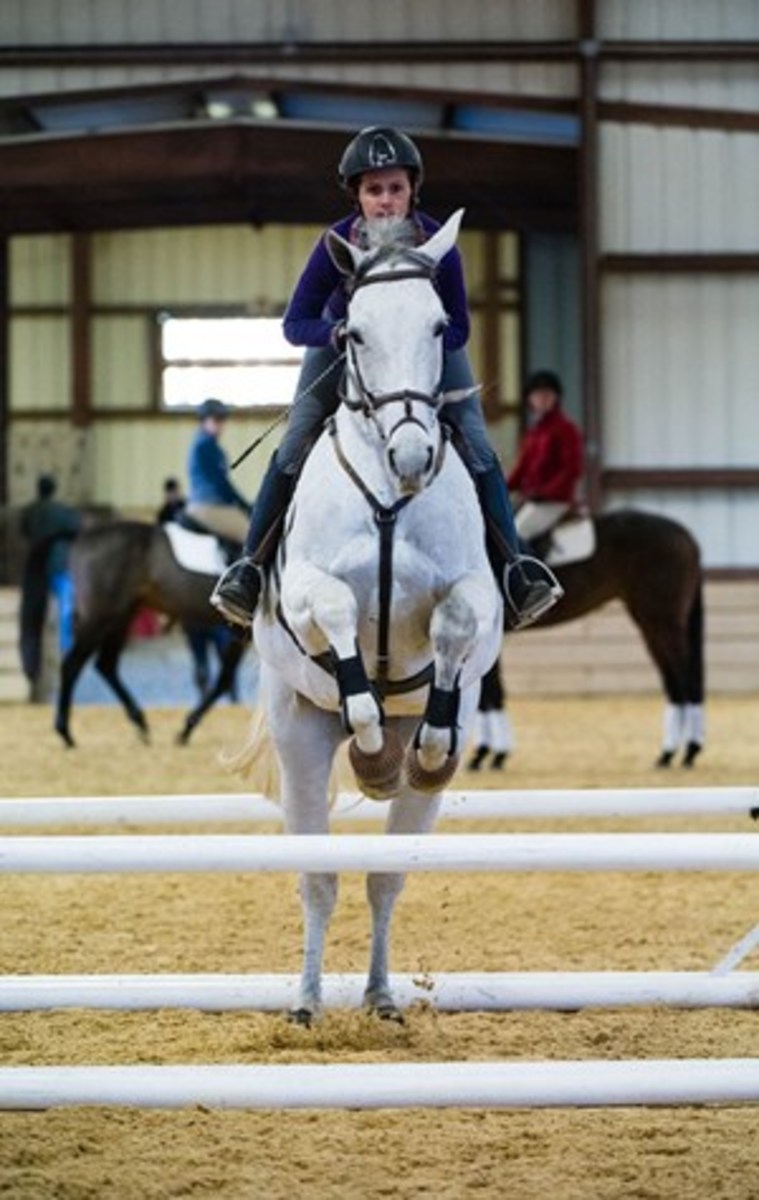
This article originally appeared in the April 2015 issue of Practical Horseman.










